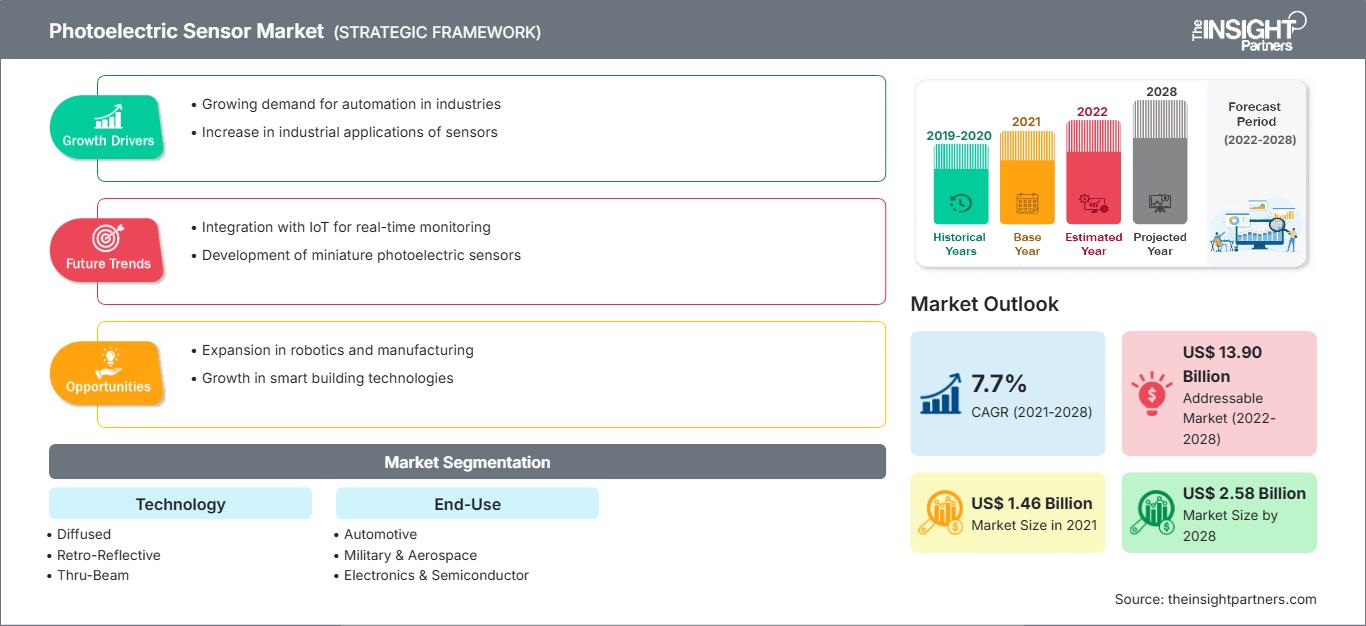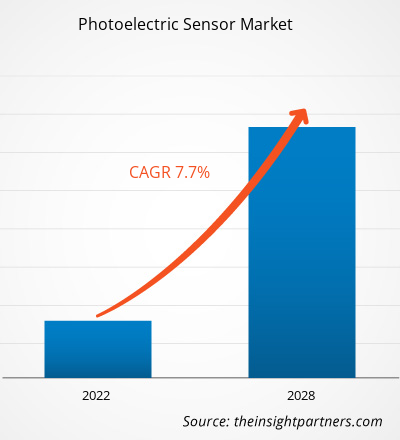[Rapporto di ricerca] Il mercato dei sensori fotoelettrici è stato valutato a 1.458,23 milioni di dollari nel 2021 e si prevede che raggiungerà i 2.577,56 milioni di dollari entro il 2028; si prevede una crescita a un CAGR del 7,7% dal 2021 al 2028.
I sensori fotoelettrici stanno guadagnando popolarità grazie alla loro elevata affidabilità e alle capacità di rilevamento degli oggetti a lungo raggio, indipendentemente da dimensioni, forma, colore, materiale e proprietà superficiali degli oggetti. Questi sensori sono progettati per funzionare in condizioni difficili; inoltre, sono dotati di tecnologie avanzate per garantire una soppressione affidabile dei riflessi indesiderati. Queste capacità li rendono più versatili di molti altri tipi di sensori e adatti all'uso industriale. Ad esempio, i sensori retroriflettenti con filtri di polarizzazione rilevano la posizione di un carrello di qualsiasi forma e materiale, che deve essere mantenuto dentro e fuori dai binari di un ottovolante. Inoltre, i sensori fotoelettrici sono ampiamente utilizzati nei settori militare e aerospaziale grazie alla loro elevata precisione e affidabilità. Vengono utilizzati negli aerei cargo per il rilevamento di fumo e incendi. Inoltre, i sensori fotoelettrici aiutano i produttori di cellule e motori a monitorare parametri dei sistemi aerospaziali come pressione, temperatura, accelerazione, posizione ottica e velocità. Inoltre, l'industria della difesa utilizza ampiamente apparecchiature di rilevamento biologico per rilevare la presenza di sostanze chimiche nell'ambiente e per valutare il rischio di potenziali minacce biologiche rilevando materiali biologici nocivi, al fine di salvaguardare sia la popolazione militare che quella civile. Pertanto, la precisione e l'affidabilità dei sensori fotoelettrici li rendono una tipologia di sensore preferita in condizioni industriali difficili.
Impatto della pandemia di COVID-19 sul mercato dei sensori fotoelettrici
Secondo l'ultimo rapporto dell'Organizzazione Mondiale della Sanità (OMS), Stati Uniti, Spagna, Italia, Francia, Germania, Regno Unito, Russia, Turchia, Brasile, Iran e Cina sono tra i paesi più colpiti dall'epidemia di COVID-19. Nel 2020, l'economia mondiale ha subito conseguenze significative e si prevede che gli effetti persisteranno in una certa misura anche negli anni a venire. L'epidemia ha sconvolto settori primari come l'elettronica, i semiconduttori e la produzione manifatturiera. Un forte calo della crescita in questi settori sta limitando la crescita del mercato dei sensori fotoelettrici. La chiusura delle fabbriche, i divieti di viaggio e di commercio e i blocchi alle frontiere per combattere e contenere l'infezione hanno avuto un impatto negativo sulla produzione, la fornitura e le vendite di vari prodotti per la sensoristica.
Personalizza questo rapporto in base alle tue esigenze
Potrai personalizzare gratuitamente qualsiasi rapporto, comprese parti di questo rapporto, o analisi a livello di paese, pacchetto dati Excel, oltre a usufruire di grandi offerte e sconti per start-up e università
Mercato dei sensori fotoelettrici: Approfondimenti strategici

- Ottieni le principali tendenze chiave del mercato di questo rapporto.Questo campione GRATUITO includerà l'analisi dei dati, che vanno dalle tendenze di mercato alle stime e alle previsioni.
Potrai personalizzare gratuitamente qualsiasi rapporto, comprese parti di questo rapporto, o analisi a livello di paese, pacchetto dati Excel, oltre a usufruire di grandi offerte e sconti per start-up e università
Mercato dei sensori fotoelettrici: Approfondimenti strategici

- Ottieni le principali tendenze chiave del mercato di questo rapporto.Questo campione GRATUITO includerà l'analisi dei dati, che vanno dalle tendenze di mercato alle stime e alle previsioni.
I produttori di sensori fotoelettrici si stanno concentrando sulla riduzione dei costi operativi per rimanere competitivi. Tuttavia, si prevede che riprenderanno le attività produttive durante la fase post-lockdown. Si prevede che le iniziative governative per stimolare l'economia e l'allentamento dei lockdown alimenteranno la domanda di sensori fotoelettrici durante il periodo di previsione. È probabile che la domanda di sensori fotoelettrici aumenti con la crescente adozione di nuove tecnologie nei settori automobilistico e aerospaziale.
Approfondimenti sul mercato dei sensori fotoelettrici: la crescente domanda di sensori fotoelettrici nel settore farmaceutico stimola la crescita del mercato dei sensori fotoelettrici
Le aziende farmaceutiche si concentrano sul miglioramento delle loro attività produttive complessive, evitando discrepanze come le confezioni vuote, che possono essere causate dalla mancata disponibilità di compresse di medicinali sulla linea di produzione. Il settore sta implementando sempre più sensori fotoelettrici per il conteggio delle compresse, il riempimento dei flaconi e la verifica del conteggio (negli studi clinici). Questi sensori vengono utilizzati anche nei dispositivi automatici per l'evasione delle prescrizioni presso farmacie e ospedali. Inoltre, i progressi nei sensori fotoelettrici in termini di portata di rilevamento, che ne migliorano la precisione di conteggio, insieme al mantenimento di ambienti di produzione igienici escludendo il contatto umano durante il confezionamento dei medicinali, sono i vantaggi associati ai sensori fotoelettrici. I sensori fotoelettrici offrono inoltre una soluzione economica, ottenuta tramite linee di produzione automatiche nell'industria farmaceutica. Pertanto, l'aumento dell'adozione di sensori fotoelettrici nelle aziende farmaceutiche è principalmente attribuito alla loro capacità di migliorare l'efficienza, ridurre i costi operativi del settore e facilitare il monitoraggio della produzione in tempo reale. Questi sensori automatizzano la misurazione dei livelli superiori e inferiori dei liquidi in contenitori o serbatoi. L'uso di sostanze chimiche fortemente corrosive (acide o basiche) è comune nelle aziende farmaceutiche e, pertanto, il rilevamento dei livelli dei liquidi nei serbatoi di stoccaggio è un compito importante in questi impianti. Pertanto, l'aumento dell'utilizzo di sensori fotoelettrici nell'industria farmaceutica guiderà la crescita del mercato dei sensori fotoelettrici nei prossimi anni.
Approfondimenti di mercato basati sulla tecnologia
In base alla tecnologia, il mercato dei sensori fotoelettrici è segmentato in diffusori, retroriflettenti e sbarranti. Nel 2020, il segmento retroriflettente ha rappresentato la quota di mercato maggiore.
Approfondimenti di mercato basati sull'utente finale
In base all'utente finale, il mercato dei sensori fotoelettrici è segmentato in automotive, militare e aerospaziale, elettronica e semiconduttori, packaging e altri. Nel 2020, il segmento automotive ha rappresentato la quota di mercato maggiore.
Gli operatori che operano nel mercato dei sensori fotoelettrici adottano strategie come fusioni, acquisizioni e iniziative di mercato per mantenere le proprie posizioni sul mercato. Di seguito sono elencati alcuni sviluppi dei principali attori:
- Ad aprile 2020, Balluff Photoelectric Sensors ha fornito dati di monitoraggio delle condizioni. Il portfolio di sistemi di automazione e monitoraggio intelligenti (SAMS) include sensori fotoelettrici affidabili, monitoraggio delle condizioni e tecnologie IO-Link avanzate, tutte pensate per ridurre i tempi di fermo macchina semplificando la risoluzione dei problemi, il cambio formato e la configurazione delle macchine.
- A febbraio 2020, Eaton Corp plc è stata inserita nella lista delle aziende più ammirate al mondo nel 2020 dalla rivista Fortune.
Approfondimenti regionali sul mercato dei sensori fotoelettrici
Le tendenze regionali e i fattori che influenzano il mercato dei sensori fotoelettrici durante il periodo di previsione sono stati ampiamente spiegati dagli analisti di The Insight Partners. Questa sezione illustra anche i segmenti e la geografia del mercato dei sensori fotoelettrici in Nord America, Europa, Asia-Pacifico, Medio Oriente e Africa, America Meridionale e Centrale.
Ambito del rapporto di mercato sui sensori fotoelettrici
| Attributo del rapporto | Dettagli |
|---|---|
| Dimensioni del mercato in 2021 | US$ 1.46 Billion |
| Dimensioni del mercato per 2028 | US$ 2.58 Billion |
| CAGR globale (2021 - 2028) | 7.7% |
| Dati storici | 2019-2020 |
| Periodo di previsione | 2022-2028 |
| Segmenti coperti |
By Tecnologia
|
| Regioni e paesi coperti | Nord America
|
| Leader di mercato e profili aziendali chiave |
|
Densità degli operatori del mercato dei sensori fotoelettrici: comprendere il suo impatto sulle dinamiche aziendali
Il mercato dei sensori fotoelettrici è in rapida crescita, trainato dalla crescente domanda degli utenti finali, dovuta a fattori quali l'evoluzione delle preferenze dei consumatori, i progressi tecnologici e una maggiore consapevolezza dei vantaggi del prodotto. Con l'aumento della domanda, le aziende stanno ampliando la propria offerta, innovando per soddisfare le esigenze dei consumatori e sfruttando le tendenze emergenti, alimentando ulteriormente la crescita del mercato.

- Ottieni il Mercato dei sensori fotoelettrici Panoramica dei principali attori chiave
- Diffuso
- Retroriflettente
- A sbarramento
Per utente finale
- Automotive
- Militare e aerospaziale
- Elettronica e semiconduttori
- Imballaggio
- Altro
Per area geografica
- Nord America
- Stati Uniti
- Canada
- Messico
- Europa
- Francia
- Germania
- Italia
- Regno Unito
- Russia
- Resto d'Europa
- Asia Pacifico (APAC)
- Cina
- India
- Sud Corea
- Giappone
- Australia
- Resto dell'APAC
- Medio Oriente e Africa (MEA)
- Sudafrica
- Arabia Saudita
- Emirati Arabi Uniti
- Resto del MEA
- Sud America (SAM)
- Brasile
- Argentina
- Resto del SAM
Profili aziendali
- Autonics Corporation
- Balluff GmbH
- Eaton Corporation plc
- Ifm Electronic GmbH
- Keyence Corporation
- OMRON Corporation
- Rockwell Automation, Inc.
- Panasonic Corporation
- SICK AG
- Schneider Electric SE
- Analisi storica (2 anni), anno base, previsione (7 anni) con CAGR
- Analisi PEST e SWOT
- Valore/volume delle dimensioni del mercato - Globale, Regionale, Nazionale
- Industria e panorama competitivo
- Set di dati Excel
Report recenti
Rapporti correlati
Testimonianze
Motivo dell'acquisto
- Processo decisionale informato
- Comprensione delle dinamiche di mercato
- Analisi competitiva
- Analisi dei clienti
- Previsioni di mercato
- Mitigazione del rischio
- Pianificazione strategica
- Giustificazione degli investimenti
- Identificazione dei mercati emergenti
- Miglioramento delle strategie di marketing
- Aumento dell'efficienza operativa
- Allineamento alle tendenze normative






















 Ottieni un campione gratuito per - Mercato dei sensori fotoelettrici
Ottieni un campione gratuito per - Mercato dei sensori fotoelettrici